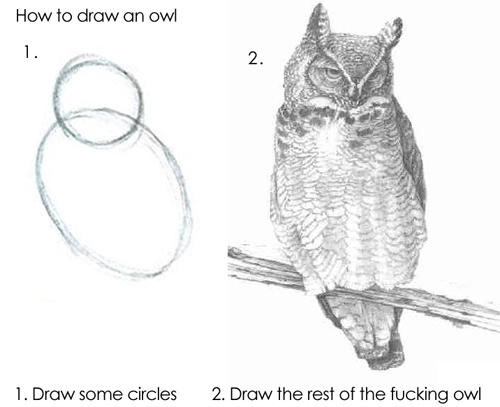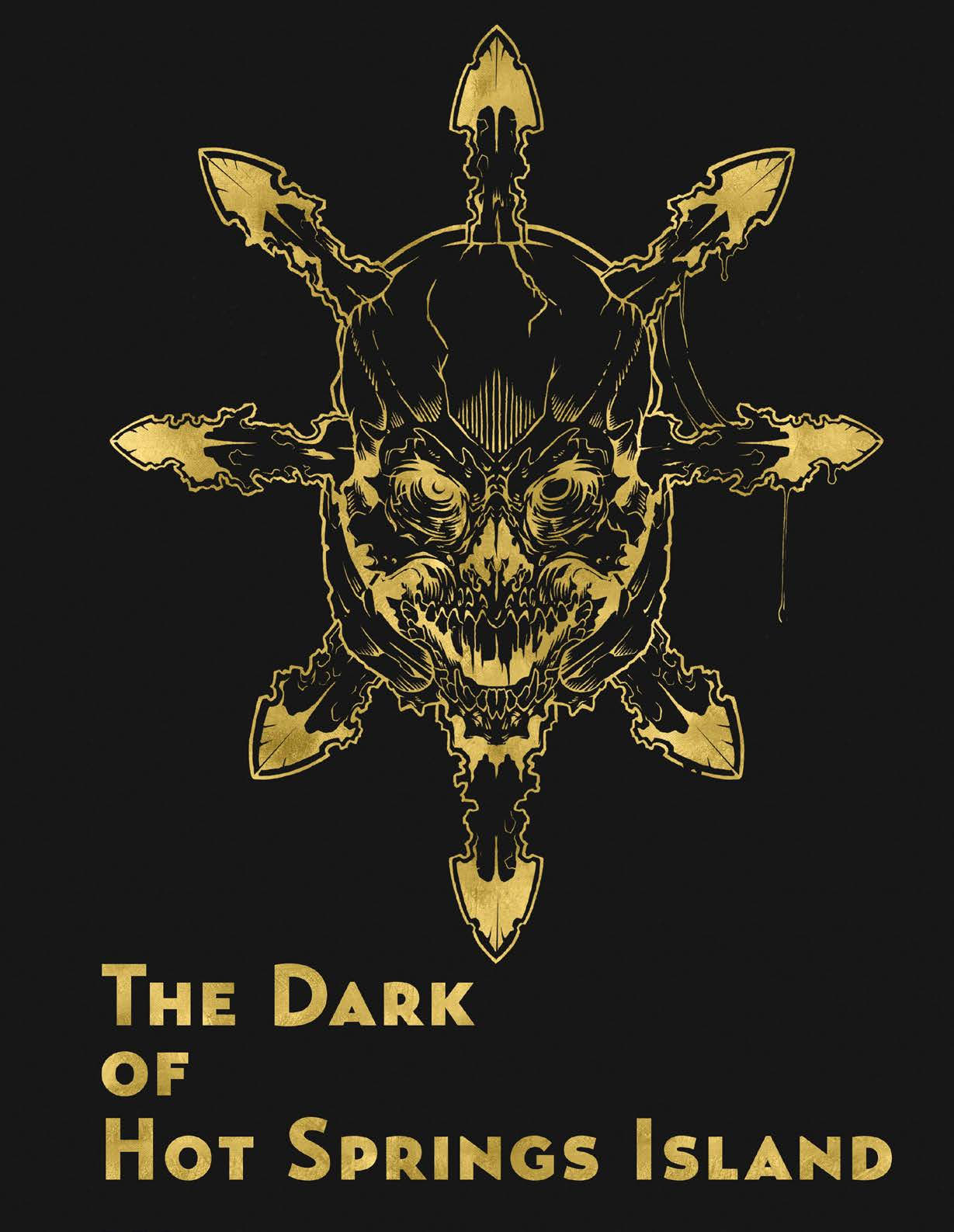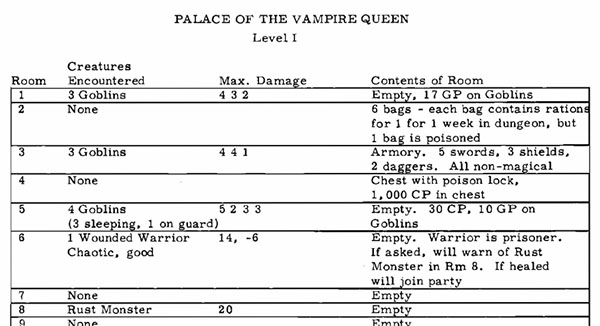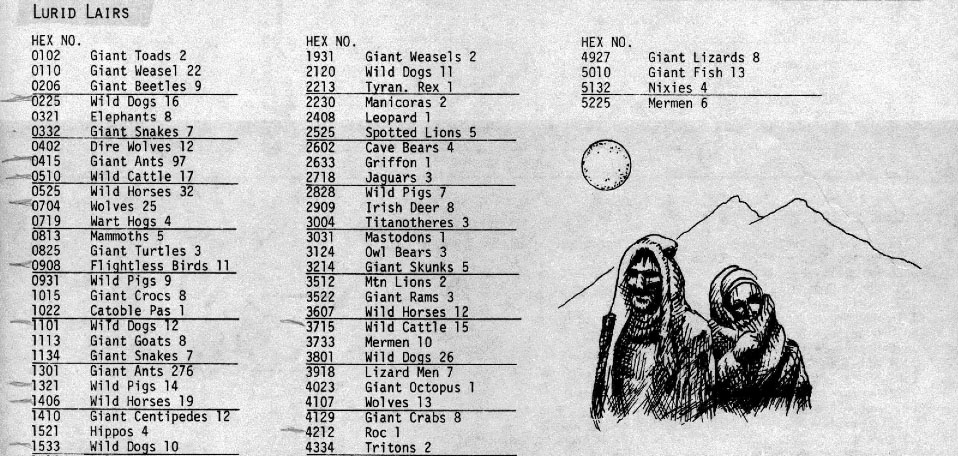As described in The Art of the Key, the first published module for D&D was Palace of the Vampire Queen. It used a very simplistic, tabular key:
A year later, Judges Guild would release Wilderlands of High Fantasy, the first published hexcawl. This book keyed only a fraction of the hexes on its map, also using mostly tabular methods:
Different table formats were presented for Lurid Lairs (above), Villages, and Citadels & Castles.
These tablular entries are supplemented with short, one or two sentence entries like these:
1002-Above Ground Ruined Temple-3 Windwalkers
2822-Overgrown Antique Paintings-Copper Dragon
1418 Isle of Grath – Abode of four huge Ogres which relish human flesh. Every Ogre has three eyes, and flaming red hair. A pet giant crocodile follows them to feast on the leavings.
(“Overgrown Antique Paintings” is just a typo. Based on the format of other entries, it should be specifying an overgrown something in which antique paintings are the treasure to be looted from a copper dragon. The image it conjures of a copper dragon living inside magical antique paintings that one can presumably enter is just too fantastic for me not to call it out here. But I digress.)
But whereas the published presentation of dungeons has significantly developed and improved over the last 40+ years, the presentation of hexcrawls largely has not. If you pick up virtually any of the OSR hexcrawls released over the past few years, you’ll still find:
Incomplete keys, in which lots of hexes aren’t keyed at all. This is generally an indication that your hexcrawl is at the wrong scale. This creates two problems in actual play. First, it tends to create very poor pacing (with long spans of time in which navigational decisions are not resulting in interesting feedback in the form of content). Second, the lack of content equates to a lack of structure. One obvious example of this is that hexcrawls with vast spans of empty space lack sufficient landmarks in order to guide navigation.
Underdeveloped keys that aren’t ready for actual play. Telling me that there is, for example, a dungeon in a particular hex with “Hobgoblins 42” in it doesn’t actually give me any meaningful information for bringing that dungeon into play.
Perhaps the most egregious example of this sort of thing are products like Carcosa, which feature keys almost entirely generated by rolling on the random stocking tables found in the back of the book and jotting down the result. There’s zero value in such a key. Why? Because you could just as easily roll on the random stocking tables yourself.
Transitory keys, in which the content keyed to a hex is something you only encounter once and then the hex is functionally empty the next time you go there. (For example, from Isle of the Unknown, “A 9th-level cleric… in a red surcoat with a white cross rides southeast to take ship upon a holy pilgrimage.”) Because this content effectively deletes itself from the key, over time this transitory content turns even a complete key into an incomplete one. It should instead be encoded as a random encounter (or similar structure).
SO WHAT?
Why is this a problem?
Well, imagine if we designed dungeons this way.
THE TOMB OF SAGRATHEA
Level 1: 12 skeletons.
Level 2: The original laboratories of the lich Sagrathea, now divided into a tribe of 17 ghost eaters and a kingdom of 46 skeletons locked in war with each other.
Level 3: The walls of the Bloodpool Labyrinth are of pinkish flesh which bleeds a grease-like substance if injured. There are many traps here. Patrolled by 2 flaming skulls.
Level 4: [intentionally left blank]
Level 5: [intentionally left blank]
Level 6: 121 skeletons + 4 ogre skeletons.
Level 7 – Sagrathea’s Gardens: A collection of 27 caverns each rendered as a miniature biome. Sagrathea has recorded his spellbook in these gardens, with each garden cavern recording a single spell of the 4th to 9th level of potency.
Level 8 – Sagrathea’s Manse: The lich Sagrathea sits upon a throne of black stone with his wight bride.
You can add in a side-view illustration of the dungeon showing each level’s vertical elevation, but if you can imagine looking at this dungeon “key” and being asked to run the Tomb of Sagrathea, then you know how I generally feel when I open up a typical hexcrawl and see the “key” inside.
There’s a real “draw the rest of the fucking owl” vibe to it.

WHAT SHOULD A HEXCRAWL LOOK LIKE?
Published hexcrawls are, in my opinion, providing a poor example of the value a hexcrawl structure is actually capable of providing.
At a basic level, I want to be able to pick up a hexmap and its key and have a fundamentally playable experience.
 At a more advanced level, once you have a fully functional hexcrawl, there’s all kinds of cool utility that you can leverage out of that hexcrawl. For example, in Thinking About Wilderness Travel I looked at how the basic scaffolding for rich route-based travel basically just falls out of a properly designed hexcrawl key. Hexcrawls can also provide the context and tools for rapidly restocking empty dungeon complexes, as described in (Re-)Running the Megadunegon.
At a more advanced level, once you have a fully functional hexcrawl, there’s all kinds of cool utility that you can leverage out of that hexcrawl. For example, in Thinking About Wilderness Travel I looked at how the basic scaffolding for rich route-based travel basically just falls out of a properly designed hexcrawl key. Hexcrawls can also provide the context and tools for rapidly restocking empty dungeon complexes, as described in (Re-)Running the Megadunegon.
You can see the sample hex key I included as part of my longer series on hexcrawls.
If you’re looking for something like this on the market right now, check out The Dark of Hot Springs Island by Jacob Hurst, Gabriel Hernandez, Even Peterson, and Donnie Garcia. Every hex is keyed with content. Every lair and dungeon is mapped. And it’s paired to the incredible Field Guide to Hot Springs Island, an incredibly rich handout that’s designed to be given to your players as a kind of rumor table on steroids. It’s not just everything I want in a hexcrawl product; it’s more than that. And it’s the absolute gold standard to which any hexcrawl supplement should aspire.














THE TOMB OF SAGRATHEA
You must admit that the two circles for the owl are well rendered at least in terms of size, relationship, and perhaps a feeling of motion. Like the dungeon, off to a good start but also still not recognizable for what it ultimately is (meaning for the dungeon, playable at the game table). Good stuff.
God, I love Hot Springs Island so much. It represents a massive leap forward in hexcrawl (and adventure) presentation. The subtle strength of Island’s presentation lies in the creativity and vision of the setting itself. The Island, its inhabitants and conflicts, ride a very particular vibe, a little Heavy Metal and a little Moorcock. Thanks to how the book’s organized and written, the reader gets on that vibe right away. All of those unconventional ideas and tones, they just click. More importantly, as a DM, I understand how to *run them at the table.* It’s stylish, but practical.
Only twice in my life have I felt I could immediately run a campaign after the first reading: Hot Springs Island and 13th Age’s “Eyes of the Stone Thief.”
My mind went in a totally different direction from yours when I tried to interpret what “Overgrown Antique Paintings” could mean. I pictured a ruin (inhabited by a copper dragon) with vine-covered murals or frescos on the walls.
At this point in my life I think I prefer Wilderlands style hexcrawls to Hot Springs Island. There’s just *too much* in HSI. Too much to remember and juggle. Not enough room to insert my own stuff. Wilderlands on the other hand gives me just a sketch of a world, some key locations, some procedural generation tools, and a whole lot of empty space I can fill with *anything*. In other words, I just want a basic chassis for my hexcrawl, and see the lack of detail as a perk not a drawback. It’s definitely not beginner friendly, but that’s ok, not everything has to be beginner friendly.
That’s an interesting perspective, because there’s really nothing that needs to be remembered or juggled in HSI: PCs enter hex. You look at the page for that hex. Done.
As an experienced GM, on the other hand, I find the original Wilderlands book to be basically useless. If I was completely new to hexcrawls,the procedural content generators would be insightful tools. But little else in the book is giving me anything that couldn’t be generated or improvised in the middle of play.
(Later Wilderlands supplements and the 3.5 revision tend to flesh the material out enough to have SOME utility.)
This may be just a fundamental disconnect. I know there also people who find “Room 6: 12 skeletons” to be the superior dungeon key, whereas I consider that to be completely useless to the point where a blank sheet of paper would have a superior value to me. “Monster + # of monsters” is something for the random stocking tables to take care of.
Yeah, I’m baffled too. I’m not familiar with Hot Springs Island (I’d never heard of it before yesterday, in fact), but unless it features a complex web of political alliances like Fading Suns, I don’t see how inserting your own stuff would be a problem. Like, you do realize you can replace the content with your own, right? They even give you explicit permission to do so in the introduction (which is part of the free preview on DTRPG): “So ignore pieces. Add new ones. Throw things out, or change them up completely.”
It feels like buying a box full of cool toys and then complaining that there’s not enough room in the box for your other toys.
I ran into this problem with Forbidden Lands. I read the books, the players were excited about the premise of the setting, and we all had fun with the character creation. Then, once we started playing, I had to improvise 95% of the content. There was almost nothing keyed on this gigantic map.
I mean, in hindsight I realize that the books explicitly state this is how the game is designed, but it still ended up letting me down. We only played a couple of sessions before we moved on.
Hey, big fan. I’ve been lurking this site for a while, but this thread finally got me out of the shadows.
I am currently reading ‘The Dark of Hot Springs Island’, and it’s incredible. I love it! I love it as an adventure and a piece of art. As a hexcrawl though? There are what, 21 hexes? Part of the delight for me of playing through X1 (4 or 5 times now) or CRPG’s like Neverwinter or Baldur’s Gate is clearing up the unknown. Sometimes there’s nothing there but there’s still the pleasure of filling in the blanks (or clearing away the black) on the map.
I get that having vast swathes of nothing brings little value to the table, but surely there’s a happy middle ground between filling up a tiny island with lush detail but little room to explore and an empty continental expanse full of disjointed random events. There’s an old article in Trollsmyth where he discusses the size and number of features in medieval Sherwood Forest that maybe best encapsulates this. Not sure if I’m allowed to post the link here.
Unrelated to the hex crawl conversation, but as an aside to the gushing praise for Swordfish, I’d like to say that the system-agnostic format is pretty frustrating here. It’s hard to tell in many cases if unique creatures are meant to be overcome by the PC’s or impossible adversaries meant to be fled from. Also, what the heck is going on with the trap in the Bath House? Is there a solution?
Anyway, thanks for another incredible addition to the Hex Crawl series!
Here’s that Trollsmyth article for those interested in it. I’m hoping to finally tackle an essay on sub-hex navigation in the near future that’s been bouncing around my head for a few years now, but we’ll see if that actually happens.
Hot Springs Island is not, in my mind, the Platonic perfection of the hexcrawl form. Partly because I don’t think there is such a thing: It’s okay for the form to vary based on what you’re trying to do with it.
Things I think about when looking at HSI critically:
– I don’t like system neutral supplements. You strike to the heart of the matter in terms of inefficiency of presentation and lack of clarity in mechanical intent.
– I don’t like 2-mile hexes. They pair poorly with D&D movement rates. HSI addresses this by adjusting the movement rate so that characters are moving at 1/5th or 1/6th the normal rate of movement, which basically causes them to arrive back at
– I generally prefer hexes to NOT be keyed with multiple locations. The whole point of the hexcrawl structure is to abstract navigation, but if you routinely have multiple locations in a single hex you’ll basically guarantee that the PCs will want to navigate between those locations, negating the entire point of using a hexmap in the first place.
HSI is going a different route with their multiple pieces of content, though, by using a structure in which you can spend a watch to move to a hex (and automatically encounter a piece of content) and then spend a watch to explore that hex in order to find another piece of content. They’re trying to tackle your “I want to fill in the blanks on the map” itch in depth rather than breadth.
(AFAICT, they still lack any guidelines for sub-hex navigation, though.)
In my standard hexcrawl I achieve a similar effect by NOT having the content of a hex automatically encountered upon entering the hex. You can run into stuff while traveling through a region, but if you actually want to clear the hex and/or find something specific in a particular area, you need to stop and survey.
I’m planning to experiment with HSI’s structure and see what I think of it in actual play. But if you wanted a more traditional hexcrawl, I think you could pretty easily:
– Triple the number of hexes, splitting each piece of content out into its own hex.
– Increase the scale of the hexes to 12 miles per hex (my preferred scale).
That would give you probably a 6 x 11 grid of hexes, representing a much larger island.
Similarly, if I were running Isle of Dread, I would reduce the number of hexes on the map (by re-mapping to a 12-mile scale instead of a 6-mile scale) and probably at least triple the amount of keyed content.
Re: One piece of content per hex.
As Trollsmyth points out in that article linked above, there’s almost certainly A LOT MORE STUFF in any given hex than the one piece of keyed content. But, IMO, the hexes where we care enough to drill down and find all that stuff are more the exception than the rule.
Yes, Sherwood Forest is important because we’re going to spend a lot of time there. But that’s not going to be true of every 12-mile hex.
This is something that either the GM can consciously focus (“they’ve made their base of operations in Sherwood, so let’s take a closer look at what’s in that hex”) or that the PCs can choose to focus on (“we’re made our base of operations in Sherwood, we should figure out what else is going on in this hex”).
The old hex clearing procedures were one way of responding to this focus.
If you look at my standard hexcrawl structure, you’ll also see that the encounter system I designed organically lays in more details in hexes where the PCs spend more time: Because it generates not just random creatures but also LAIRS that are added to the current hex, the more time the PCs spend in a particular hex, the more lairs (i.e., points of interest) will be dynamically added to the hex.
(Since the encounters can include the lairs humans, goblins, etc., some of those lairs will be villages, abbeys, hunting lodges, castles, etc.)
So if the PCs spend all of their time in or around the 12-mile hex that represents Sherwood, that hex will fill up with content.
@Justin
You should check The Evils of Illmire. It’s an sandbox hexcrawl released last year (I guess). More vanilla than hot springs.
There are only 19 hexes. But each one of them have at least a half-page description, and a specific wandering monster table. And most of them have fully keyed dungeons of one or two pages. Some NPCs and organizations also have a dedicated page.
It seemed really close to that hexcrawl ideal you described.